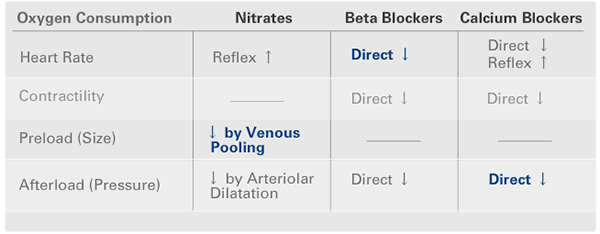Medical Therapy
Drug therapy with nitrates, beta blockers and calcium channel blockers favorably affects the relationship between myocardial oxygen supply and demand. They act primarily to reduce oxygen demand, that is, myocardial oxygen consumption. Nitrates also increase myocardial blood supply.
The major determinants of myocardial oxygen consumption are heart rate, contractility and wall tension. The major determinants of wall tension are preload, or ventricular cavity size, and afterload, or blood pressure.
Medications were also prescribed to treat his symptoms of angina pectoris. Nitrates reduce oxygen consumption primarily by venodilatation, reducing preload. They cause arteriolar dilatation, reducing afterload, and by dilating the coronary arteries, they increase myocardial blood flow. Typically, sublingual nitroglycerin relieves angina within 2-3 minutes. Long-acting nitrates reduce the incidence of anginal attacks. To avoid tolerance, the long- acting nitrates should be given with a ten to twelve hour nitrate-free interval.
Beta blockers reduce oxygen consumption primarily by reducing heart rate and contractility. Heart rate is the major determinant of myocardial oxygen demand. They also decrease afterload. In addition, they reduce platelet aggregation by blocking epinephrine, have a beneficial antiarrhythmic effect and have been shown to increase survival. In our patient, the beta blocker was also used to decrease his ventricular response rate to atrial fibrillation.
Calcium channel blockers reduce oxygen consumption primarily by reducing afterload, and most calcium channel blockers reduce contractility. Long acting agents should be used, and short acting agents should be avoided, as they may have significant adverse effects. Calcium channel blockers are especially important when beta blockers are not tolerated and when ischemia persists in spite of adequate doses of nitrates and beta blockers. However, neither nitrates nor calcium channel blockers have been shown to increase survival.
 The table above summarizes the mechanism of action of nitrates, beta blockers and calcium channel blockers in the treatment of angina pectoris. Note their effects on the determinants of myocardial oxygen demand or consumption. These include heart rate, contractility, preload, or heart size, and afterload, or blood pressure.
The primary mechanism of action of each agent is highlighted. While several actions may be important, nitrates act primarily by reducing preload through venous pooling, beta blockers by reducing heart rate and calcium channel blockers by reducing afterload. The three classes of drugs work synergistically, and one may counteract the side effects of another. For example, the reflex increase in heart rate of nitrates is balanced by the direct reduction of heart rate by beta blockers.
The table above summarizes the mechanism of action of nitrates, beta blockers and calcium channel blockers in the treatment of angina pectoris. Note their effects on the determinants of myocardial oxygen demand or consumption. These include heart rate, contractility, preload, or heart size, and afterload, or blood pressure.
The primary mechanism of action of each agent is highlighted. While several actions may be important, nitrates act primarily by reducing preload through venous pooling, beta blockers by reducing heart rate and calcium channel blockers by reducing afterload. The three classes of drugs work synergistically, and one may counteract the side effects of another. For example, the reflex increase in heart rate of nitrates is balanced by the direct reduction of heart rate by beta blockers.
The major determinants of myocardial oxygen consumption are heart rate, contractility and wall tension. The major determinants of wall tension are preload, or ventricular cavity size, and afterload, or blood pressure.
Medications were also prescribed to treat his symptoms of angina pectoris. Nitrates reduce oxygen consumption primarily by venodilatation, reducing preload. They cause arteriolar dilatation, reducing afterload, and by dilating the coronary arteries, they increase myocardial blood flow. Typically, sublingual nitroglycerin relieves angina within 2-3 minutes. Long-acting nitrates reduce the incidence of anginal attacks. To avoid tolerance, the long- acting nitrates should be given with a ten to twelve hour nitrate-free interval.
Beta blockers reduce oxygen consumption primarily by reducing heart rate and contractility. Heart rate is the major determinant of myocardial oxygen demand. They also decrease afterload. In addition, they reduce platelet aggregation by blocking epinephrine, have a beneficial antiarrhythmic effect and have been shown to increase survival. In our patient, the beta blocker was also used to decrease his ventricular response rate to atrial fibrillation.
Calcium channel blockers reduce oxygen consumption primarily by reducing afterload, and most calcium channel blockers reduce contractility. Long acting agents should be used, and short acting agents should be avoided, as they may have significant adverse effects. Calcium channel blockers are especially important when beta blockers are not tolerated and when ischemia persists in spite of adequate doses of nitrates and beta blockers. However, neither nitrates nor calcium channel blockers have been shown to increase survival.
